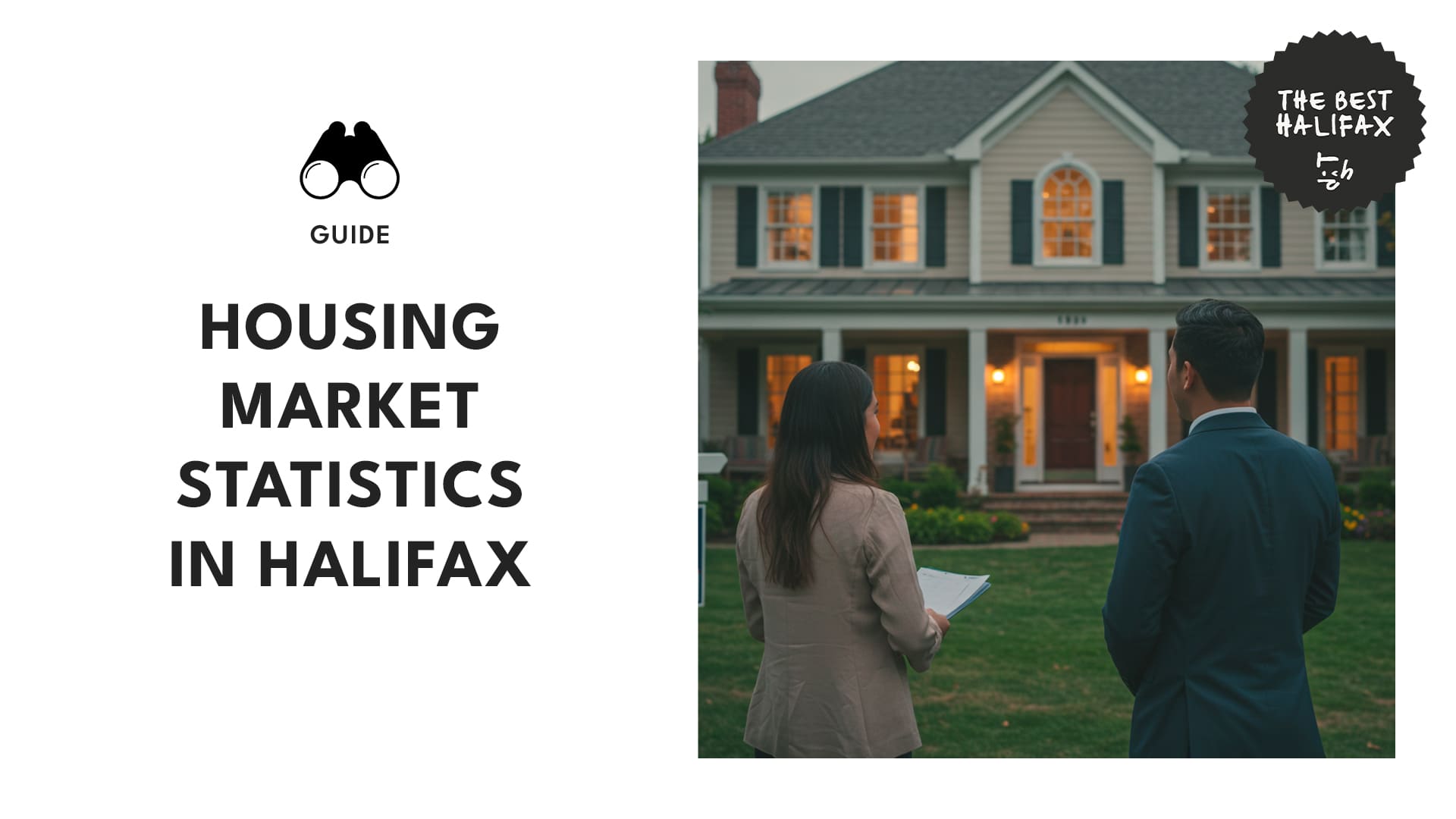- Key Insights
- Prices of Properties in Halifax
- Regional Analysis of Housing Trends Across Canada
- Most Expensive Neighborhoods in Halifax
- Homeless Demographics in Halifax
- Costs and Consequences of Rising Home Prices in Halifax
- Interventions and Solutions to Rising House Prices in Halifax
- The Future of Halifax’s Housing Market
- References
Key Insights
| A report on the Halifax Housing Market Outlook for 2025 indicates that the average home sale price in the city increased by 4.4%, reaching $578,913 in 2024, which is up from $554,269 in 2023. The Halifax Housing Market Report shows that detached houses remain the most expensive property type, with an average price of $688,898. These homes saw a 15% increase in value compared to the previous month. AreaVibes reports that Halifax has a citywide cost-of-living index of 91, with Point Pleasant Park ranking as the most expensive neighborhood. This area has a cost-of-living index of 127, which is 40% higher than the city average. According to the Affordable Housing Association of Nova Scotia (AHANS), data from March 5, 2025 indicates that Halifax’s homeless population rose to 3,295 individuals, which is an increase of 20 from the previous week. Data from the Sandbox Project highlights how nationwide, the average rate for household housing spending has exceeded 60% of family income. |
A report on the Halifax Housing Market Outlook for 2025 highlights significant changes in the city’s real estate landscape from 2023 to 2024. The report shows rising prices, increased sales volume, and more home listings in Halifax.
These shifts in the city indicate a growing demand for housing fueled by population growth and economic stability. With more buyers entering the market, competition has intensified.
For example, the average sale price for homes in the city climbed by 4.4% to $578,913 in 2024, compared to $554,269 in 2023. Over the same period, total sales transactions also grew by 8.0%, increasing from 4,173 to 4,508.
Moreover, the number of home listings also rose by 7.6%, reaching 6,028 in 2024, compared to 5,604 the previous year.
In 2025, the market is expected to transition into a seller’s market, with home prices projected to rise by 5.0% to $607,859.
Sales transactions are anticipated to grow by 6.0%, while total listings are expected to expand at a slightly slower rate of 4.0%.
Additionally, new listings are predicted to increase by 3.0%, which reflects a stable but moderate supply boost.
This market momentum is largely driven by first-time homebuyers and immigrants, particularly those looking for single-detached homes.
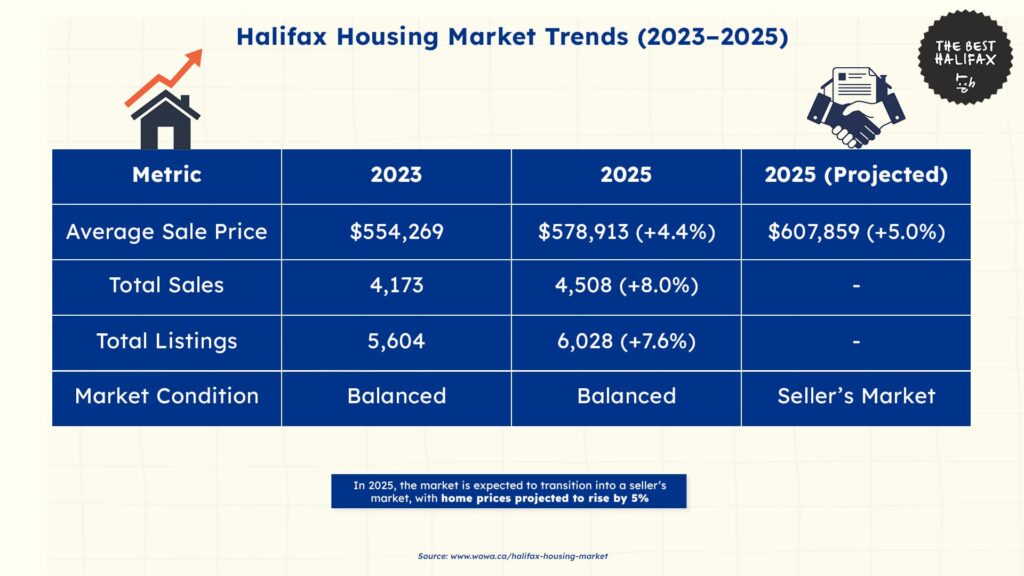
Prices of Properties in Halifax
The Halifax Housing Market Report reveals the current prices of different property types across Halifax.
Halifax’s real estate market continues to experience increasing prices in all types of properties, with the overall selling price averaging $603,575 in January 2025.
This represents a 5% increase from the previous month, a 4% quarterly increase, and a 6% rise year-over-year.
Despite the general growth in housing prices, the volume of transactions has decreased 15% from the last month and 50% from the last quarter. This reflects fewer properties sold and purchased as prices rise.
Detached houses continue to be the priciest type of property, with a mean price of $688,898. These houses experienced a 15% growth in their value when compared to the previous month and a 13% growth both on a quarterly and yearly basis.
Overall sales for detached houses, however, dropped 38% from last month, 63% from last quarter, and 26% on a yearly basis. This indicates that increasing prices could be slowing down deals in the city’s market.
Meanwhile, townhouses experienced a sharper price hike, with the average sold price at $472,313 in January 2025. This represents a 15% increase monthly, 11% quarterly, and 14% yearly.
In contrast to detached houses, townhouse sales experienced a 100% rise in transactions in the last month, while quarterly sales dropped by 20%. This indicates increasing buyer demand for cheaper multi-unit housing as detached home prices rise.
Furthermore, Halifax apartments averaged a selling price of $495,870, which shows an 8% rise over the last month and a 10% yearly increase. These rates persist even though prices fell by 2% over the quarter.
As all types of property have enjoyed annual price appreciation, Halifax’s housing market continues to be competitive, though affordability issues are driving consumers to townhouses and apartments.
Detached houses could continue to experience declining sales as costs increase, but multi-unit properties are likely to gain popularity among homeowners.
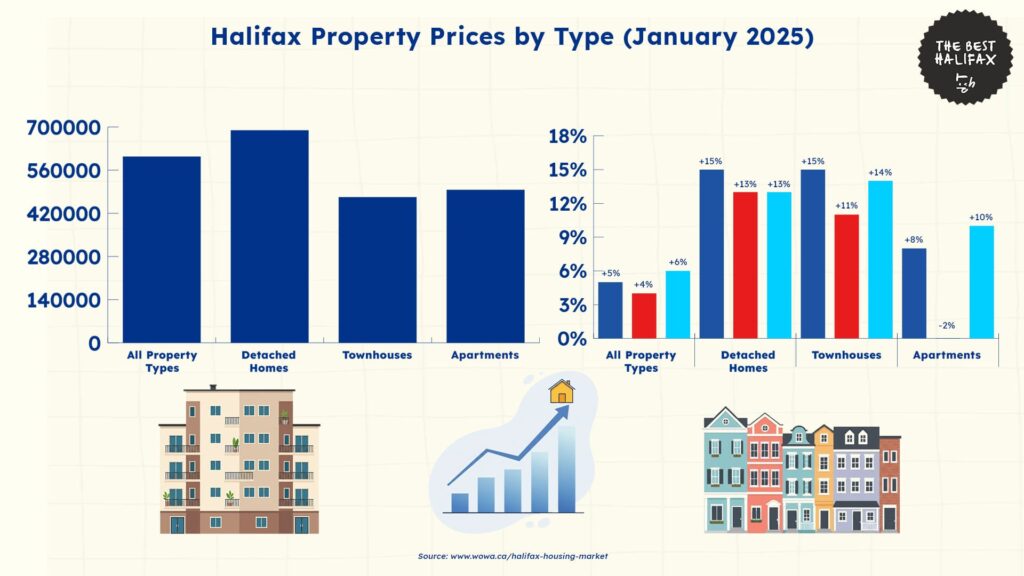
Regional Analysis of Housing Trends Across Canada
Data collected by Spring Financial shows that Nova Scotia’s real estate market is still less expensive than many other provinces in Canada, though it continues to experience some gradual price appreciation.
In 2023, Nova Scotia’s average home price was $402,200, putting it around the mid-range among Canadian provinces.
Among the provinces, Nova Scotia’s housing costs fall between more expensive regions like Quebec, with a rate of $495,200, and more affordable ones like New Brunswick at $330,100.
This number is still lower than Ontario’s $868,067 and British Columbia’s $979,221, where prices are the highest in the country.
Additionally, Nova Scotia still remains considerably more affordable than northern territories in the country, such as Nunavyt and Yukon, with prices of $550,000 and $661,400, respectively.
However, Nova Scotia’s rate is still higher than Saskatchewan’s $324,400 and Newfoundland and Labrador’s $306,100.
Even with its comparative affordability, Halifax housing demand is pushing prices higher.
These rises indicate that while the housing market within Nova Scotia remains more affordable compared to national figures, urban hubs such as Halifax are seeing competitive price increases.

The report further shows how Canadian housing prices have varied throughout the last decade, with a general upward trend.
For example, the Canadian average home price in 2013 was $391,820, which then increased to $657,145 by 2023. This shows a rise of 67.7% in 10 years.
Certain markets, including British Columbia and Ontario, have experienced steep increases in prices, while Nova Scotia has experienced a more moderate growth.
With Halifax becoming a seller’s market in 2025, affordability will be an increasingly important issue.
Given that another 5.0% price growth is anticipated for the city next year, demand for single-detached houses, especially from first-time buyers and immigrants, will continue to boost the housing market.
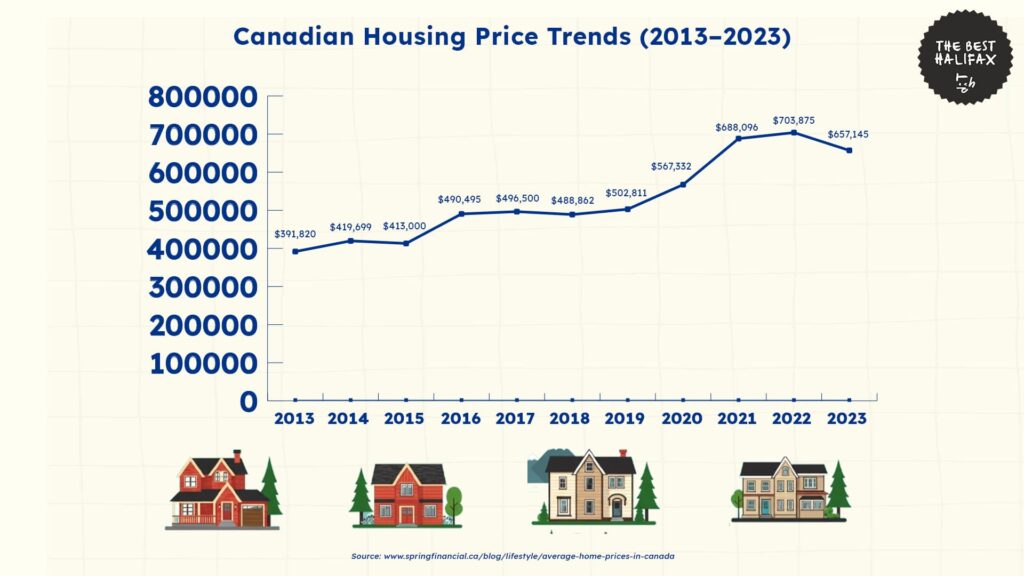
Most Expensive Neighborhoods in Halifax
AreaVibes illustrates how Halifax’s priciest areas are a reflection of wider trends in the city’s housing market, as higher home prices and demand for desirable locations are bringing up living costs.
The citywide cost-of-living index is 91. In high-demand locations, this number increases substantially, with prices that are out of reach of the typical buyer.
Since housing costs in Halifax rose by 4.4% between 2023 and 2024 and are forecast to increase another 5.0% in 2025, these higher-end neighborhoods will probably experience even greater price increases.
Point Pleasant Park, the most costly neighborhood, has a cost of living index of 127. This is 40% above the city average of 91, partly because it is situated on the water and property values are high.
Beaufort Avenue South and Jubilee Road, with their living costs at 35% and 32% above the city average, respectively, also follow the city’s housing trends.
These neighborhoods, which are popular for historic homes and central locations, are highly competitive in Halifax’s changing seller’s market.
Similarly, communities such as Quinpool Road and Robie Street, which are 29% and 24% more expensive than the city average, respectively, also experience high demand.
Even in the mid-range of expensive neighborhoods, Mulgrave Park, South End Halifax, and Spring Garden maintain higher-than-average living costs, reflecting the overall increase in property values across Halifax.
As supply for housing lags behind demand, even traditionally less expensive neighborhoods, like Westmount Subdivision and Schmidtville, where prices are 11% above the city average, can expect increasing pressure on affordability.
Given that home prices are expected to hit $607,859 by 2025, Halifax’s housing market trends show that higher-end neighborhoods will continue to appreciate.
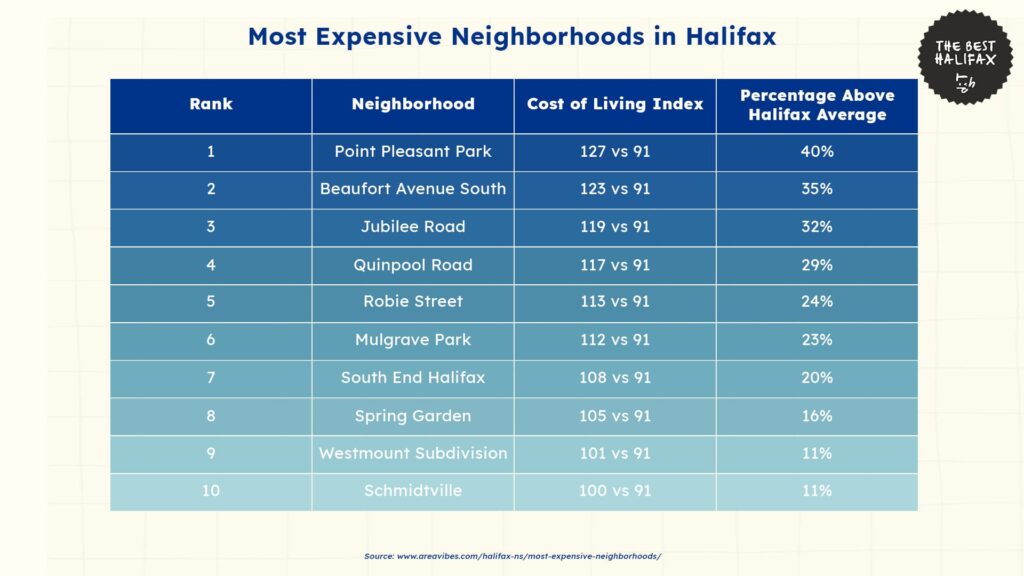
Homeless Demographics in Halifax
According to the Affordable Housing Association of Nova Scotia (AHANS), the continued increase in housing prices in Halifax has caused issues in housing affordability and homelessness in the city.
With house prices increasing by 4.4% in 2024 and further expected to increase by 5.0% in 2025, even more individuals are finding it difficult to secure stable housing.
Data from March 5, 2025, shows that Halifax’s homeless population reached 3,295 individuals, which is an increase of 20 from the previous week.
Of these numbers, 1,140 people were categorized as actively homeless, which is also an increase of 3 individuals from the previous week.
Sheltered homelessness, encompassing people in emergency shelters or transitional housing, fell from 636 to 626. This represents a drop of 10 people.
Meanwhile, unsheltered homelessness stayed the same at 216 individuals, indicating that many continue to be denied stable housing.
Hidden homelessness, covering people temporarily living with family or friends, rose from 253 to 263. This shows an increase in unstable housing situations where people are not permanently housed but not outside of formal homeless systems.
Chronic homelessness and tri-morbidity instances, including those with mental health, drug use, and physical health issues, also had modest increases.
Active chronic homelessness and tri-morbid homelessness both increased by 1 individual. These categories increased by 703 to 702 and by 169 to 170, respectively.
These reflect the continued stress on Halifax’s housing system, where increasing expenses and scarce affordable housing place numerous vulnerable populations in jeopardy.
Without increased housing initiatives, the number of homeless people could still increase, especially as Halifax shifts into a seller’s market in 2025.

Costs and Consequences of Rising Home Prices in Halifax
A report by the Sandbox Project highlights how the rising cost of housing in Halifax has significant economic and social consequences for its population.
Historically, housing costs were recommended to be under 30% of family income. Yet, in large Canadian cities, such as Halifax, this threshold has become more and more out of reach.
Across the country, the average household housing expenditure has risen to over 60% of family income, which is more than double this historical guideline.
This significant financial weight reduces the residents’ disposable income for other necessary needs, including healthcare, education, and transportation.
Moreover, high housing prices also lead to heightened levels of stress and poor mental health among residents. The financial hardship arising from unaffordable housing can cause depression, anxiety, and a lowered quality of life.
Additionally, the unavailability of affordable housing alternatives might drive individuals and families into poor-quality dwellings or badly overcrowded housing, which further worsens health and social issues.
Overall, the increasing housing prices in Halifax not only burden individual budgets but also present greater social issues, such as health consequences and heightened homelessness.
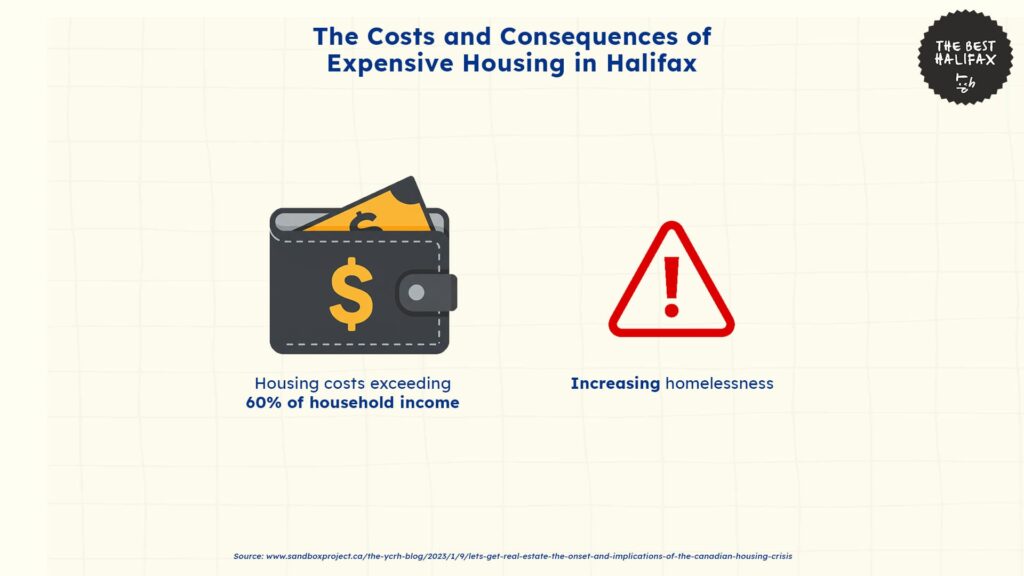
Interventions and Solutions to Rising House Prices in Halifax
To mitigate increasing housing costs in Halifax, the federal and provincial governments have initiated strategic measures to enhance the housing supply, affordability, and protection of vulnerable groups.
The National Housing Strategy (NHS) of the Government of Canada has made a commitment of more than $75 billion over a period of ten years to address housing issues across Canada.
Various programs under this strategy aim to increase housing availability and affordability.
Moreover, the Affordable Housing Fund lends money at below-market rates to developers for affordable housing developments. This initiative contributes another $1 billion over three years from 2025 to 2026 to speed up construction.
Meanwhile, the Housing Accelerator Fund (HAF) is a $4 billion program that encourages cities to expedite housing approvals and concentrate on constructing multi-unit housing like duplexes and triplexes to alleviate supply constraints.
Additional federal actions involve changes to mortgage regulations to enable more purchasers to enter the market.
As of September 2024, the government raised the insured mortgage limit to $1.5 million from $1 million, which allows more buyers to qualify for a down payment of 5%.
Furthermore, 30-year mortgages are now open to first-time homebuyers and those purchasing newly constructed homes. This aims to enhance affordability and encourage new home construction.
These policy reforms hope to make homeownership more achievable and support the development of housing stock in cities like Halifax.
Regionally, Manitoba’s Three-Year Action Plan (2022 – 2025) under the NHS also contains policies that can help with Halifax’s rising house prices.
The plan focuses on updating and enhancing social housing so that currently occupied community housing units are renovated and kept affordable for the long term.
Here, there is a significant emphasis placed on building new affordable housing units to meet increasing demand and curb further price hikes.
The plan also channels investments into assisting vulnerable groups through rent supplements and homelessness prevention programs, which helps low-income families to obtain stable housing.
Raising the supply of low-cost housing through government-backed developments would stabilize price increases and enhance access for low- and middle-income families in Halifax.
Alongside this, targeted assistance for the vulnerable, such as rent relief programs, would minimize homelessness and mitigate pressure on the overall housing market.
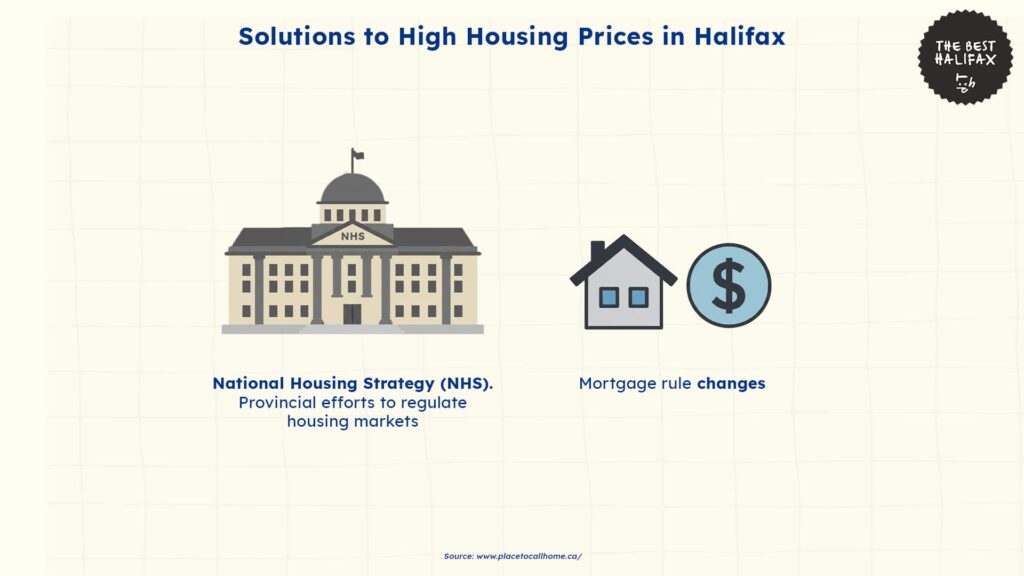
The Future of Halifax’s Housing Market
Halifax’s real estate market is predicted to follow an upward trend, with housing prices increasing by 5% in 2025.
The city’s shift forward to a seller’s market indicates more competition among buyers, especially for single-detached homes.
With these rising prices, affordability will become even more of a challenge, especially for first-time homebuyers and low-income families.
With increasing housing prices, concealed homelessness and housing insecurity are also likely to persist, adding further pressure on Halifax’s support systems.
While government interventions like affordable housing programs and mortgage policy changes can bring some relief for families, it may take some time for beneficiaries to feel the effects of these policies.
In the long run, Halifax’s market dynamics will be influenced by population growth, economic circumstances, and the effectiveness of policies.
If home building does not keep up with demand, price appreciation could speed up, and the affordability gap could grow.
As Halifax continues to advance into a high-cost housing market, strategic planning will be crucial to maintain sustainable growth and housing affordability for residents.
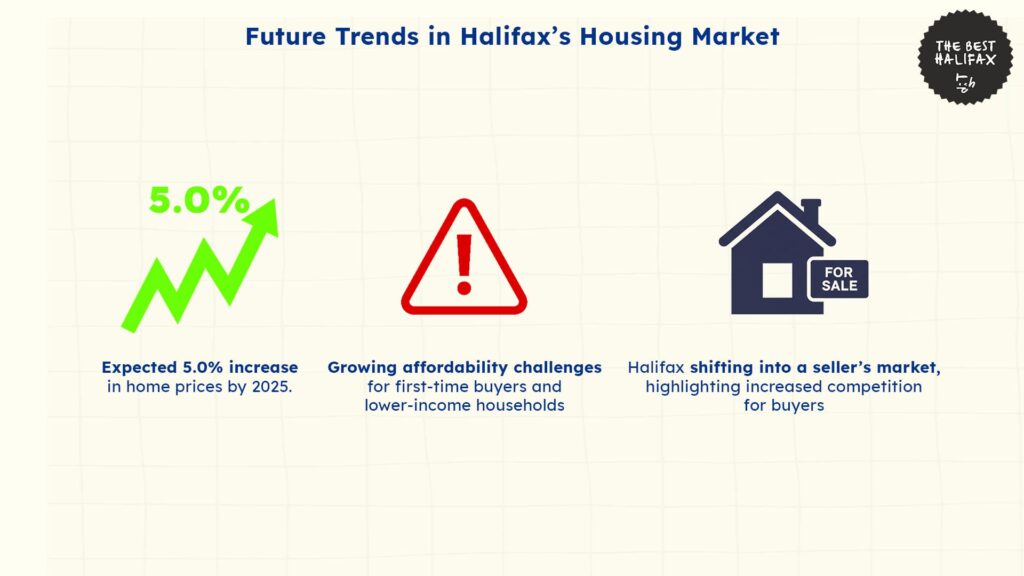
References
- Affordable Housing Association of Nova Scotia. (n.d.). AHANS home. Retrieved from https://www.ahans.ca/
- Affordable Housing Association of Nova Scotia. (n.d.). AHANS housing report. Retrieved from https://www.ahans.ca/_files/ugd/282dfd_c435c69422fd4124a07382eba538f23f.pdf
- WOWA. (n.d.). Halifax housing market. Retrieved from https://wowa.ca/halifax-housing-market
- Canada Mortgage and Housing Corporation. (n.d.). Affordable housing fund. Retrieved from https://www.cmhc-schl.gc.ca/professionals/project-funding-and-mortgage-financing/funding-programs/all-funding-programs/affordable-housing-fund
- Canada Mortgage and Housing Corporation. (n.d.). Housing accelerator fund. Retrieved from https://www.cmhc-schl.gc.ca/professionals/project-funding-and-mortgage-financing/funding-programs/all-funding-programs/housing-accelerator-fund
- Government of Canada. (n.d.). A place to call home: Canada’s national housing strategy. Retrieved from http://www.placetocallhome.ca/
- Government of Canada. (2024). Canada’s housing plan: A roadmap to affordability. Retrieved from https://housing-infrastructure.canada.ca/housing-logement/housing-plan-report-rapport-plan-logement-eng.html
- Government of Manitoba. (2022). National housing strategy: Three-year action plan (2022-23 to 2024-25). Retrieved from https://www.gov.mb.ca/housing/pubs/nhs-second-three-yr-action-plan-22-23-to-24-25.pdf
- Government of Manitoba. (2022). Manitoba’s three-year housing plan (2022-23 to 2024-25). Retrieved from https://www.gov.mb.ca/housing/three-yr-plan-22-23to24-25.html
- Re/Max Canada. (2024). Halifax housing market outlook. Retrieved from https://blog.remax.ca/halifax-housing-market-outlook/
- Sandbox Project. (2023). Let’s get real estate: The onset and implications of the Canadian housing crisis. Retrieved from https://sandboxproject.ca/the-ycrh-blog/2023/1/9/lets-get-real-estate-the-onset-and-implications-of-the-canadian-housing-crisis
- Spring Financial. (2023). Average home prices in Canada. Retrieved from https://www.springfinancial.ca/blog/lifestyle/average-home-prices-in-canada
- Areavibes. (2023). Most expensive neighborhoods in Halifax, NS. Retrieved from https://www.areavibes.com/halifax-ns/most-expensive-neighborhoods/
